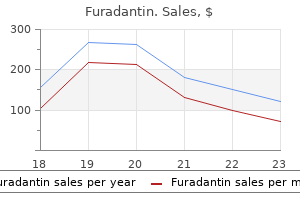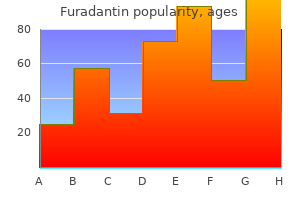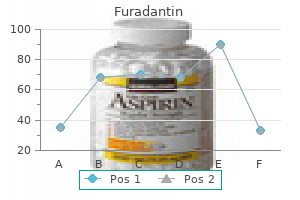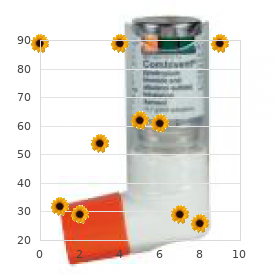Furadantin dosages:
Furadantin packs: 2 creams, 3 creams, 4 creams, 5 creams, 6 creams, 7 creams, 8 creams, 9 creams, 10 creams

Order furadantin 50 mg amex
In a unicuspid valve, the opening is elliptical but happens across a radius quite than the diameter of the valve. The dimensions of the ascending aorta must be measured, and coarctation within the descending aorta must be sought, particularly in those with bicuspid aortic valves. The imply gradient across the valve may be measured by calculating the area under the Doppler envelope. The highest measured velocity is used to calculate the peak transvalvular gradient. It is usually inconceivable with Doppler to precisely differentiate the contribution of every stage of obstruction to the entire. Flow in a vessel is the product of the cross-sectional space (A) of the vessel and the velocity (V). If the patient is in atrial fibrillation, 10 consecutive beats ought to be measured and averaged for both velocity measurements. The peak gradient measured throughout catheterization is the peak-to-peak gradient, which is lower than the height instantaneous gradient obtained with echocardiography. Because the two-catheter method requires cannulation of both femoral arteries, one other acceptable technique of measuring the peak-to-peak gradient is catheter pullback from the left ventricle to the ascending aorta. These trigger much less hypotension due to peripheral arterial vasodilation, less bradycardia, much less transient myocardial dysfunction, and less osmotic diuresis after the process. Continuity equation measures the physiologic space (vena contracta) and as such is smaller than that measured by Gorlin. Unless the affected person has a valve prosthesis or prior historical past of infective endocarditis, antibiotic prophylaxis prior to dental procedures is not beneficial in patients with valvular pathology. Overly aggressive diuresis may cause hypotension if hypovolemia significantly impairs cardiac output by diminishing preload. Nitrates also can trigger hypotension and syncope by decreasing preload and should be averted or used with extreme warning. It is beneficial that these patients bear vigilant monitoring with cautious hemodynamic monitoring. The stented valve is deployed throughout speedy pacing to allow enough time for profitable placement. Paravalvular leak is still widespread following valve deployment, and the technique has appreciable morbidity, not least because it has been used up to now in very ill sufferers (see Chapter 66). The relative benefits, disadvantages, and indications for use of the totally different prostheses are outlined in Chapter 18. Problems with pulmonary homograft are widespread in adults who underwent this operation. Aortic valve homografts have been used to treat youthful sufferers, especially those who want to avoid anticoagulation, within the hope that higher sturdiness of this valve might end result than with a bioprosthesis. Unfortunately, newer information suggest that any durability benefit of a homograft over a bioprosthesis in middle-aged patients is slight. These valves are most often used to deal with sufferers older than 60 years as a result of structural deterioration is much slower on this age group in contrast with younger sufferers. Because of the sewing ring and struts, all prostheses, each mechanical and biologic, have a pressure gradient throughout them, even with normal operate. The threshold to insert bioprostheses at a younger age continues to decline given the wonderful quality of life these afford. These all require anticoagulants to minimize the chance of valve thrombosis and thromboembolism. These valves are durable if anticoagulation is maintained and careful antibiotic prophylaxis is used over the years. Mechanical valves are used with warning in older patients (> 65 years) given the substantial increase in anticoagulation-related hemorrhage and resultant mortality in this population. A minority of asymptomatic patients, nonetheless, could die all of a sudden or have rapid development of illness.
Order furadantin australia
In contrast to the limited clinical utility of plain radiography for the identification of a selected poison or to diagnose poisoning, plain radiography and different kinds of diagnostic imaging in medical toxicology may be extremely useful for the prognosis of toxicantinduced pathology and to help the medical toxicologist within the ongoing treatment and patient-management phases of the drug overdose. Detection of drug-induced noncardiac pulmonary edema is related to critical intoxication with salicylates and opioid agonists (Stern et al. Plain chest radiography can detect this abnormality, which would probably correlate with the findings noticed during physical examination of the lungs. This radiographic discovering would increase the severity stratification of the poisoning case and probably alter the planned therapeutic technique for the affected person. The initial medical analysis of the poisoned affected person is a critically necessary section of the therapeutic process to treat poisoned people. The bodily, laboratory, and radiological examination all contribute to the preliminary diagnostic steps for poison treatment. The physical and laboratory examinations are generally utilized more from a diagnostic and acute administration standpoint, whereas the radiological examination tends to be more useful for detection and management of toxicant-induced pathology. Prevention of Further Poison Absorption During the early phases of remedy of a poisoned patient who has had a toxic publicity via the oral, inhalation, or the topical route, the opportunity to stop further absorption of the poison to minimize the total quantity of chemical that reaches the systemic circulation could also be potential. For chemicals presented by the inhalation route, the main intervention to stop further absorption is removal of the patient from the setting where the toxin is discovered and to provide adequate air flow and oxygenation for the affected person. For topical exposures, affected person clothing containing the chemical should be eliminated and correctly disposed in hermetic wrappings or containers to be positive that the rescuers and healthcare suppliers are adequately protected from secondary publicity. Most topical exposures require mild washing of the pores and skin with water and delicate cleaning soap taking care not to cause cutaneous abrasions of the skin which will enhance dermal absorption. The optimum time to intervene to stop continued absorption of an oral poison is as quickly as possible after the ingestion. The 4 major strategies are currently obtainable for this objective: induction of emesis with syrup of ipecac, gastric lavage, oral administration of activated charcoal, and whole-bowel irrigation. Historically, induction of emesis was completed by a wide range of concoctions such as tartar emetic, an antimony salt, mustard combined in water, concentrated solutions of copper and zinc salts, and numerous botanical substances. In hospitals, apomorphine injection was given even in the Nineteen Eighties to cause emesis in patients with a history of potentially poisonous ingestion. At present, syrup of ipecac is the only agent obtainable for induction of emesis within the therapy of a doubtlessly toxic ingestion. Syrup of ipecac as a chemical for the prevention of toxicant absorption has largely been changed by activated charcoal, which is discussed below. As acknowledged, the efficacy to remove gastric contents, and due to this fact reduce subsequent absorption of the chemical declines with increase within the time interval between poison ingestion and syrup of ipecac administration (Neuvonen et al. An necessary space of concern with the decline in use and eventually availability of syrup of ipecac is that, for chemical substances not adsorbed by activated charcoal, there exists a possible void for efficient remedy to stop additional absorption of orally ingested toxins. Many medical toxicologists consider that there remains a restricted role for the medical use of syrup of ipecac, primarily is rural areas the place the length of time earlier than a poisoned affected person can reach medical care is significant, particularly when the chemical ingested is poorly adsorbed to activated charcoal. The use of gastric lavage, the strategy of placing an orogastric tube into the abdomen and aspirating fluid then cyclically instilling fluid and aspirating till the effluent is clear, has also diminished significantly lately. The reasons for the decline in use of this system embrace a growing appreciation of the chance of aspiration during the lavage procedure and growing proof that the effectiveness of gastric lavage could additionally be extra limited than initially thought. Like induction of emesis, where the efficacy of the process declines with rising time interval between use of the procedure and the time of ingestion, gastric lavage too has this important limitation. It is crucial that the orogastric tube be of sufficient measurement (40�44 French for an adult) to be useful. Even with a large bore orogastric tube some tablets or capsules might not be in a position to pass through the tube. In the pediatric patient, there are sensible limitations to using massive bore tubes. In this case, orogastric lavage could solely be useful to attempt elimination of liquid toxins or presumably dissolved tablets or capsules. As described earlier, the medicinal use of charcoal dates again more than one hundred fifty years. The first reported medicinal use of oral charcoal to adsorb an ingested toxin is credited to the American physician, Hort, who, in 1834, used large quantities of powdered charcoal to successfully treat a patient poisoned with a chloride salt of mercury. A dramatic demonstration of the adsorptive effect of oral charcoal was that by Tourey, a French pharmacist who reportedly mixed a lethal dose of strychnine with charcoal and consumed the mixture earlier than his colleagues at the French Academy in 1930 (Andersen, 1946). Early in vitro investigations of the adsorptive properties of activated charcoal demonstrated the effect of charcoal on numerous chemical substances in aqueous solutions (Andersen, 1946), the effect of pH on charcoal adsorption properties (Andersen, 1947), and the impact of activated charcoal on the adsorption of strychnine from gastric contents (Andersen, 1948).

Buy generic furadantin 50mg on-line
For suspected axillary nodal metastasis from recognized primary breast cancer, both fineneedle aspiration or core biopsy can be performed. Fine-needle aspiration has been shown to have excessive sensitivity and specificity on this setting. Typically, one to three passes are made, focusing on the thickened lymph node cortex. Prone desk and "add-on" upright models can be found, and every has its own advantages and limitations. Also, a room with a prone table might be used for only a small fraction of a enterprise day. Room utilization is therefore excessive, and the detector is of Skin nick Lesion 1 B different skin nicks are perfectly acceptable, a single skin nick might suffice to entry each lesions. A, If the lesions are near one another, a single pores and skin nick can be made in a location that gives easy access to each lesions. This offers wide access to the axilla and in addition flattens the axillary pyramid, making it shallower and easier to navigate. A, Focal cortical thickening (arrow) in a lady with ipsilateral invasive breast cancer. B, Core biopsy using a handbook throw device reveals the needle traversing the thickened cortex (arrow). Complaints about neck and shoulder ache are also much less frequent with the add-on unit. Vasovagal reactions can occur when the affected person is sitting, although most biopsies could be carried out with the patient mendacity on her aspect. Posterior Lesions Positioning sufferers to enable targeting of very posterior lesions could be tough on the inclined desk because of the thickness of the table. To maximize the posterior tissue that can be included within the field of view, take away the pad from the table or use a thinner one. Use gravity as much as possible by centering the breast in the aperture and making sure it can move freely away from the chest wall. Try totally different angles-such as an indirect approach-to embrace extra of the posterior tissues. Bringing the arm via the aperture can be used to entry more posterior lesions in some circumstances. It could appear that only former gymnasts would have the power to keep this awkward place, but in our expertise, most sufferers are able to tolerate this approach quite well. Thin Breast If the breast tissue compresses to less than 2 to three cm, there is in all probability not enough thickness for the system to be positioned to the designated depth and fired with out reaching the other facet of the breast and the picture receptor (negative stroke margin). First, remember that the depth calculated by the pc locations the lesion at the heart of the sampling notch. A, the system facilities the lesion within the notch, which can result in a adverse stroke margin. B, this can be prevented by adjusting the z coordinate so that the stroke margin is zero. The lesion will then be positioned on the far finish of the notch, however sufficient samples can be obtained as long as the lesion is at least 5 mm from the deep skin surface (this is the biopsy needle dead zone). Although the pattern dimension is smaller, this alternative can permit for biopsy of some lesions which have a negative stroke margin when focused using the usual probe. Finally, a lateral side-arm biopsy attachment can usually, however not at all times, be used to pattern a lesion in a thin breast. When this approach is used, the needle could additionally be fairly near the skin and sampling towards the skin is subsequently best averted (Box 20-2). Biopsy of amorphous calcifications in a 56-year-old woman with compressed breast thickness of 26 mm using a lateral side-arm attachment. Superficial Lesions Lesions that are superficial appear to make radiologists nervous. Manufacturers could provide needles with a smaller sampling notch or plastic inserts that cowl the proximal portion of the notch. Subtle Lesions Small soft tissue density targets (masses, asymmetries, or architectural distortion) and faint calcifications are the Try a special approach. Firm compression of the breast tissue usually improves visibility of the target lesion. The surface of the breast within the window of the compression paddle must be taut and smooth.


Furadantin 50 mg discount
No single exercise modality has been proven to have superior sensitivity, though the treadmill is extra extensively accepted amongst patients and physicians. However, the treadmill normally leads to a greater stage of stress than is related to bicycle ergometry, which is more depending on affected person effort. Regardless of the train modality, a quick, complete baseline echocardiographic scan is obtained for all sufferers. Resting images are obtained in the parasternal long- and short-axis and apical two- and four-chamber views and saved digitally. An apical long-axis view could also be substituted for a parasternal long-axis view if the parasternal pictures are suboptimal. Treadmill exercise is performed with commonplace protocols in accordance with the useful status of the affected person. Post�peak stress photographs are obtained as quickly as potential (in the left lateral decubitus position) after the patient transfers from the treadmill to the imaging table. These pictures are recorded and digitized to allow comparable windows for the remaining and peak stress photographs. Cycle ergometry is started at a workload of 25 W and elevated by 25 to 50 W every 2 to 3 minutes until the patient reaches his or her stage of perceived maximal effort. Images are digitized at relaxation and at low dosage (5 to 10 g/ kg/min), pre�peak dosage (30 g/kg/min), and peak dosage. Atropine ought to be used with caution in patients that have glaucoma or benign prostatic hypertrophy. Isometric handgrip may be performed on the peak infusion rate to help achieve target heart price. Less severe unwanted effects include tremor, nervousness, and marked hypertensive and hypotensive responses. Like dobutamine, esmolol has a very short half-life and, therefore, may be preferable. A typical protocol begins at a low dose of eighty g/kg/min and is elevated every 3 minutes by 30 g/kg/min to a peak dose of a hundred and seventy to 200 g/kg/min. Symptoms normally begin to resolve inside 60 seconds after medication administration. Modern technology allows digital picture acquisition of multiple cardiac cycles and side-by-side comparison in a cut up display screen show, enabling straightforward comparison of regional wall motion at rest and peak stress or after stress. Detailed frame-by-frame evaluation of wall thickening or excursion is possible, which helps within the analysis of regional myocardial perform. Harmonic imaging has improved endocardial definition, which may be further optimized with microbubble contrast agents. Microbubble distinction brokers provide improved echocardiographic decision and allow real-time evaluation of intracardiac blood circulate. Second-generation microbubble distinction agents similar to Optison and Definity incorporate perfluoropropane gas encased in an albumin-based or phospholipid shell, are extra durable, and are able to cross the pulmonary circulation and opacify the left ventricle. Patients with pulmonary hypertension or unstable cardiopulmonary circumstances including acute coronary syndrome, worsening or unstable heart failure, critical ventricular arrhythmias, or respiratory failure now not have to have their vital indicators and oxygen saturation monitored for half-hour after injection. Significant advances have been made in 3D information acquisition without the need for off-line reconstruction. Three-dimensional imaging might shorten the acquisition period of post-exercise images or peak train photographs, allowing improved sensitivity and minimizing the technical strains imposed on the technologist obtaining the images. If photographs are obtained after the center fee has returned towards regular, the sensitivity of the test might be reduced 7. Compare the wall movement of particular person segments from rest to stress within the four-screen show to define ischemia and infarction. Then compare segments in the post-stress images to identify variations in contraction and within the development of "hinge points" eight. Avoid calling a new wall motion abnormality whether it is limited to just one myocardial segment; the abnormality should involve at least two contiguous segments taBle 49. Examples of quantitative evaluation methods embrace Doppler assessment of global systolic and diastolic operate; automated endocardial border detection using integrated backscatter; and tissue Doppler assessment of myocardial displacement, velocity, strain, and pressure fee. Tissue Doppler assessment alongside the long axis utilizing apical views permits quantification of regional longitudinal myocardial perform.

Discount 100mg furadantin with mastercard
These tumors are very uncommon and consist of benign collections of endothelial cells. Primary malignant neoplasms make up roughly 15% of all major cardiac tumors. These tumors have ill-defined vascular channels lined with atypical endothelial cells. Generally very diffuse, these tumors lead to signs in preserving with pericarditis or hemorrhagic effusion. Fibrosarcomas, lymphosarcomas, liposarcomas, and other undifferentiated sarcomas represent the remainder of main cardiac malignancies. As mentioned beforehand, most malignancies of the guts are secondary and, by definition, metastatic. The overwhelming majority of metastatic cardiac tumors happen in the pericardium and are usually carcinomas, versus sarcomas. Due to elevated prevalence, probably the most commonly found metastatic tumor to the heart is lung most cancers. The typical presentation is of pericardial effusion or tamponade or pulmonary vein obstruction from direct extension. After metastatic lung cancer, breast most cancers, lymphoma, leukemia, and renal cell carcinoma are the commonest offenders. The tumor with the greatest propensity to metastasize to the center is melanoma, followed by germ cell tumors and leukemia (Table forty one. Possibilities embody pericardial cysts, teratomas, lipomatous hypertrophy of the interatrial septum, thrombus, and sarcoid. Most surgeons carry out excision with extracorporeal circulatory help to be able to directly visualize the tumor, in addition to a careful search for metasynchronous tumors. The femoral or azygous vein is normally cannulated, as opposed to the best atrium, to avoid potential taBle 41. Mitral valve repair or replacement is often unnecessary within the absence of associated bacterial endocarditis. An analysis reviewing 106 operations for sporadic atrial myxomas noted just one perioperative death. There are restricted information relating to the usage of a minimally invasive or robotic approach to cardiac tumor resection. Regardless of the sort of surgical resection or whether the tumor is sporadic, annual follow-up noninvasive imaging is beneficial in all patients after resection. Recurrence charges of 12% to 22% have been quoted in sufferers with family histories, syndromes, and multiple tumors at original presentation versus 1% for patients with sporadic, isolated myxomas. They are not often cured by surgery due to the large quantity of cardiac tissue involved. Grasso and Nitin Barman for their contributions to earlier editions of this chapter. Carney complicated: the complex of myxomas, spotty pigmentation, endocrine overactivity and schwannomas. Clinical and echocardiographic traits of papillary fibroelastomas: a retrospective and potential study in 162 patients. Quinn Griffin Saif Anwaruddin Common Genetic Issues in Cardiovascular Disease Genetic abnormalities have been related to all forms of cardiovascular disease, including coronary atherosclerosis, rhythm disorders, aortic illness, and structural heart disease. Furthermore, the sequencing of the human genome has ushered within the era of cardiovascular genomics. The capacity to efficiently scour via the massive amount of genomic info will finally result in an improved understanding of the contributions of genetics to cardiovascular disease. It would require intensive effort and time to be succesful of outline all of the variations in all of the genes that contribute to the susceptibility to or safety from a complex trait. These variants are widespread, typically accounting for 20% to 30% of the inhabitants attributable threat, however with an odds ratio of 1. The hunt to discover uncommon variants that induce susceptibility to common diseases with high danger (or protection) will be more difficult, however eminently possible with sequencing know-how and ultra high-throughput genotyping.
Discount furadantin 100 mg with visa
Postcontrast maximum intensity projection and subtracted images reveal extensive nonmass enhancement in the anterior and middle thirds of the breast. If the department had been removed because of illness, the place would you look to see if the disease had resurfaced You would additionally probably examine the remainder of the tree to make sure there was no new signal of disease in some other branches. When imaging the patient with recognized or suspected breast most cancers (Chapter 17), we centered our attention on the affected ductal system to evaluate extent of disease. We will start by trying at the lumpectomy scar after which inside that ductal system. We will give you our greatest tips for differentiating benign postoperative adjustments from people who might characterize cancer. Reduction Mammoplasty and Mastopexy Reduction mammoplasty, mastopexy, and breast augmentation are sometimes carried out by plastic surgeons quite than breast surgeons. It is often carried out for ladies with again or shoulder problems due to the load of huge breasts. After mastectomy with reconstruction, the contralateral breast could additionally be reduced to improve symmetry of breast size. This is performed for ladies with ptotic breasts wishing to reverse the results of residing on a gravitational planet. The scars of 470 reduction mammoplasty are due to this fact seen primarily on the inferior breasts. Isolated islands of breast tissue may be seen and are the end result of separation of the tissue throughout surgery. Benign Surgical Biopsy Surgical Biopsy Terminology "Lumpectomy" literally means elimination of a palpable lump. This type of biopsy could additionally be performed when a core biopsy shows a high-risk lesion or was benign discordant. The goal of incisional biopsy is to obtain tissue for prognosis quite than to completely take away a palpable finding or known carcinoma. Changes of Surgical Biopsy In the immediate postoperative interval, small hematomas and seromas are widespread. Fluid collections in the biopsy cavity lower in size and have sometimes resolved by the point imaging is subsequent performed. If the surgery stopped right here, the nipple would now be underneath the breast mound as a outcome of that tissue and skin have been eliminated. After about 5 years, distortion after benign biopsy becomes tough to determine in most women. Significant architectural distortion more than 10 years after a benign biopsy is rare and ought to be seen with suspicion. Fat necrosis and benign dystrophic calcifications might evolve over the first year or two. Dermal calcifications in discount scars (arrows) are present in the circumareolar space. A wire (open arrows) has been positioned on the pores and skin to mark the scar in these and other images all through this chapter. A pathology report of positive or close margins is associated with a high probability of cancer remaining in the breast. If the patient had calcifications associated with the cancer, magnification views of the operative region prior to re-excision might reveal regarding residual calcifications that could be localized as a half of the re-excision surgery. These calcifications could additionally be troublesome to visualize because of the postoperative adjustments, so look back on the preoperative magnification views for comparison. It can also detect additional beforehand occult lesions distant from the location of recognized tumor. Pathologic assessment of margins is an imperfect science; 4 to five small samples of tissue are taken from the areas that appear most suspicious for most cancers on the surface of the lumpectomy tissue by gross inspection. Pathologists estimate that around 16% of the surface of a lumpectomy specimen is sampled for microscopic examination.
Furadantin 50mg amex
As such, the main makes use of of exercise electrocardiographic testing must be analysis of prognosis and as a gateway to different imaging modalities. The benefits of train electrocardiographic testing are its capability to assess a variety of prognostic markers, most significantly functional capability, which is a strong predictor of mortality, widespread availability, security, ease of administration, and comparatively low value. The evaluation of practical capability could additionally be particularly advantageous in sufferers with valvular heart disease and congenital coronary heart illness whereupon recognition of practical limitation is commonly tough to ascertain by history alone. It assists in setting safe ranges of exercise (exercise prescription) and reassuring patients and families. It is beneficial in optimization of medical therapy, in triage for depth of follow-up testing and care, and in recognition of exercise-induced ischemia and arrhythmias. The indications for exercise electrocardiographic testing are divided on the basis of the degree of chance of disease or severity of diagnosed disease, use in valvular heart illness, and use in congenital heart illness (Table 47. Contraindications to train testing are divided into absolute and relative classes (Table forty seven. Pretest probability is set on the basis of signs, age, sex, and danger elements and may be divided into very low, low, intermediate, and high (Table forty seven. Exercise electrocardiographic testing is greatest used within the analysis of a affected person at intermediate danger with an atypical history or a affected person at low risk with a typical historical past. Exercise electrocardiographic testing has the next sensitivity and specificity for individuals at high threat. Before diagnostic testing, cardiovascular medicine are withheld on the discretion of and beneath the guidance of the supervising doctor. The best possible resolution is to withdraw the -blocker over several days before an exercise check, if the take a look at is for diagnostic functions. Selection is dependent upon the affected person traits, the tools obtainable, and the familiarity and comfort of the testing personnel with the protocol. Patients must be rested for the assessment, avoiding significant exertion or exercise on the day of the evaluation. Patients ought to put on clothes that enables freedom of motion, together with strolling or running shoes, and a loose-fitting shirt with quick sleeves that buttons down the entrance. Outpatients ought to be warned that the evaluation may be fatiguing and that they might wish to have someone out there to drive them residence afterward. If the take a look at is for diagnostic purposes, it might be helpful for sufferers to discontinue prescribed cardiovascular medicine after discussion with their doctor. Antianginal agents alter the hemodynamic response to train and considerably scale back the sensitivity of electrocardiographic adjustments for ischemia. Patients taking intermediate- or high-dose -blockers should taper their medication over a 2�4-d interval to minimize hyperadrenergic withdrawal responses. If the take a look at is for practical purposes, sufferers ought to proceed their medicine regimen on their traditional schedule in order that the exercise responses shall be in preserving with responses expected throughout train training. Periods longer than this measure muscular endurance rather than cardiovascular fitness. Steady-state oxygen consumption is reached after about 2 minutes of train at a given workload. Although bicycle riding is a better methodology for testing, treadmill testing is more generally used in the United States. The main physiologic advantage of bicycle using is the flexibility to take direct measurements of workload in watts, which has direct linear relation to Mvo2. With a treadmill, the examiner can only estimate workload as a end result of workload depends on the effectivity of strolling, the burden of the affected person, and the change in vitality expenditure between walking and operating. Other advantages of a bicycle are the secure platform that it offers for electrocardiographic and blood stress recordings, the smaller amount of house it occupies, quieter use, and a decrease preliminary cost of kit. The Bruce protocol has been widely used in the past and is often the idea of older research; subsequently, comparisons are simpler. Disadvantages (1) the principle drawback of the Bruce protocol is the big increments of change in workload between phases. These protocols have extra gradual will increase in workload and could be modified to suit the individual. The Naughton protocol is sweet for older or debilitated persons and permits a gradual enhance in workload. The Cornell protocol is good for a wider vary of health levels depending on beginning grade. It permits for a gradual enhance in grade and velocity and may be started at 0%, 5%, or 10% grade, depending on health degree.

Order 100 mg furadantin visa
Potential mechanisms by which exercise improves symptoms embody augmentation of collateral circulate, improved rheologic characteristics of blood, decreased reliance on anaerobic metabolism, and higher extraction of oxygen. For sufferers with symptomatic claudication, current pointers suggest a supervised train program for 30 to forty five minutes three times every week for no less than 12 weeks (class I). Cilostazol is a kind 3 phosphodiesterase inhibitor that suppresses platelet aggregation and acts as a direct arterial vasodilator. Randomized controlled trials of sufferers with moderate to extreme claudication have demonstrated 40% to 60% will increase in maximal walking distances with 12 to 24 weeks of therapy with cilostazol 100 mg twice day by day. Common side effects related to cilostazol embody diarrhea, palpitations, and complications. Pentoxifylline is a methylxanthine spinoff that capabilities as a vasodilator and an antiplatelet agent, reduces blood viscosity, and improves deformability of erythrocytes and leukocytes to exert its results. Trials have been divergent on the efficacy of pentoxifylline and is felt to result in solely marginal enhancements in maximal walking distance and symptoms. Revascularization is indicated for "lifestyle-limiting" claudication (after failed medical therapy), rest pain, ischemic ulceration, or gangrene. In fastidiously selected sufferers, catheter-based revascularization is an attractive alternative to conventional surgical management. In the femoral popliteal area, a kind A lesion is defined as a single stenosis 10 cm in length or a single occlusion 5 cm in size. Translesional pressure gradients (criteria: threshold peak systolic difference 5 to 10 mm Hg prevasodilation and 10 to 15 mm Hg postvasodilation) ought to be obtained for angiographic lesions that appear reasonably stenotic. The remedy of alternative for focal aortoiliac disease is angioplasty with or without stenting. This strategy has a technical success rate of 90%, 2 yr patency fee of 73% to 84%, a complication fee of < 10% (usually related to the arterial access site), and periprocedural mortality rate of < 1%. For femoropopliteal illness, patency charges with percutaneous therapies are lower than these in iliac disease; subsequently, angioplasty is utilized to manage focal disease after failure of medical remedy. Various conduits, such as reversed or in situ saphenous vein grafts, Dacron grafts, and polytetrafluoroethylene grafts, can be utilized. For extreme illness beneath the popliteal artery, both percutaneous and surgical revascularization approaches have marginal outcomes with regard to limb salvage. Given the coincidence of coronary artery disease in these patients, a radical preoperative evaluation of cardiac threat ought to be carried out prior to vascular surgery. Aneurysms of the peripheral arteries, as within the aorta, are most commonly due to atherosclerotic disruption of the arterial media. The incidence of bilateral involvement in lower extremity aneurysm is excessive (45% to 68%). The biggest concern with decrease extremity aneurysms is thrombosis and thromboembolism. Lower extremity aneurysms infrequently rupture (7% to 12%), however as a lot as 60% may have an ischemic complication; due to this fact, acute limb ischemia is the commonest presenting symptom. As an aneurysm increases in size, it could compress adjacent venous and lymphatic buildings inflicting decrease extremity edema. Risk issue modification and revascularization (for symptomatic patients) are the mainstays of remedy. It is the commonest explanation for secondary hypertension, may account for 1% to 5% of all instances of hypertension, and may be the trigger of end-stage renal failure in up to 20% of new dialysis patients. Arterial duplex uses a mixture of B-mode ultrasound imaging and Doppler frequency spectral analysis. Some knowledge suggest that sufferers with an elevated resistive index could not enhance after revascularization. The check may be restricted by difficulty in obtaining measurements due to excess bowel gas or obesity. In addition, in patients with advanced renal insufficiency or renal failure, gadolinium-containing contrast brokers have been linked to nephrogenic systemic fibrosis in 2% to 3% of patients (see Chapter 51). Arteriography allows for assessment of the diploma of stenosis visually and provides the ability to acquire hemodynamic measurements (gradients) across the stenotic lesions. Disadvantages embody the requirement for intraarterial access and nephrotoxic radiocontrast. Atherosclerotic nephropathy is complicated and not simply related to stenosis of the renal artery. Two small randomized trials demonstrated that sufferers treated with percutaneous renal artery angioplasty had improved systolic blood pressure and/or blood strain management (as measured by a discount within the number or dose of antihypertensive agents used) compared with patients treated with antihypertensive therapy alone.
References
- Gilad E, Bahar I, Rotberg B, et al: Therapeutic contact lens as the primary treatment for traumatic corneal erosions. Isr Med Assoc J 6:28, 2004.
- Khoo SK, Bradley M, Wong FK, et al: Birt-Hogg-Dube syndrome: mapping of a novel hereditary neoplasia gene to chromosome 17p12-q11.2, Oncogene 20(37):5239n5242, 2001.
- Trichon BH, Felker GM, Shaw l..K, et al. Relation of frequency and severity of mitral regurgitation to survival among patients with left ventricular systolic dysfunction and heart failure. Am] Cardio12003;91(5):538-543.
- Delaney JA, Opatrny L, Brophy JM, Suissa S. Drug drug interactions between antithrombotic medications and the risk of gastrointestinal bleeding. CMAJ. 2007;177:347-351.
- Teirstein AS, Damsker B, Kirschner PA, et al. Pulmonary infection with Mycobacterium avium-intracellulare: diagnosis, clinical patterns, treatment. Mt Sinai J Med 1990;57(4):209-15.
- Biggs JSG, Allan JA. Medication and pregnancy. Drugs 1981;21:69-75.
- Shiffman ML. Optimizing the current therapy for chronic hepatitis C virus: peginterferon and ribavirin dosing and the utility of growth factors. Clin Liver Dis. 2008;12:487-505.






